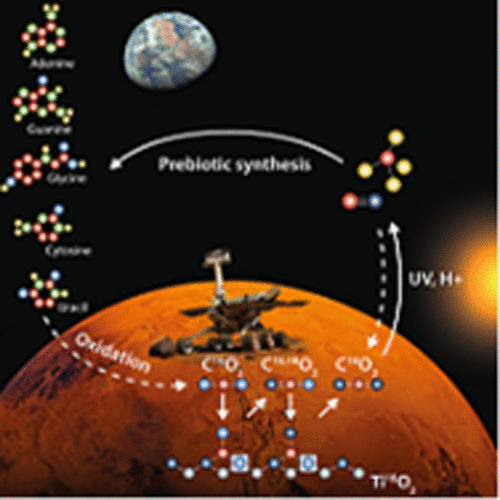当前位置:
X-MOL 学术
›
ACS Earth Space Chem.
›
论文详情
Our official English website, www.x-mol.net, welcomes your
feedback! (Note: you will need to create a separate account there.)
Abiotic Formation of Methane and Prebiotic Molecules on Mars and Other Planets
ACS Earth and Space Chemistry ( IF 2.9 ) Pub Date : 2021-04-30 , DOI: 10.1021/acsearthspacechem.1c00041 Svatopluk Civiš 1 , Antonín Knížek 1, 2
ACS Earth and Space Chemistry ( IF 2.9 ) Pub Date : 2021-04-30 , DOI: 10.1021/acsearthspacechem.1c00041 Svatopluk Civiš 1 , Antonín Knížek 1, 2
Affiliation

|
We explored the photocatalytic (UV-driven) reduction of CO2 on mineral surfaces in acidic conditions and observed the production of methane. Based on our measured laboratory reaction rates, we estimate a 2.81 × 107 cm–2 s–1 methane surface flux on the current-day Mars. We also estimate a Martian methane destruction rate of 2.37 × 105 cm–2 s–1, which is 2 orders of magnitude less than the production rate. The flux of the photochemically produced methane therefore seems sufficient to explain the background levels of methane detected on Mars. This photocatalytic reduction is part of a proposed novel reaction network tightly bound to the chemistry of CO2 in planetary atmospheres described in this paper. The emergent methane-enriched atmosphere can be transformed by high-energy-density events on rocky planets to nucleic acid bases and amino acids. Finally, destructive processes, such as volcanic eruptions or lightning storms, can turn the synthesized products back into CO2 in any step. This proposed scenario should be, in our opinion, included in models of exoplanetary chemistry.
中文翻译:

甲烷和益生元分子在火星和其他行星上的非生物形成
我们探索了在酸性条件下矿物表面上光催化(紫外线驱动)还原CO 2的过程,并观察了甲烷的产生。根据我们测得的实验室反应速率,我们估计当前火星的甲烷表面通量为2.81×10 7 cm –2 s –1。我们还估计火星的甲烷破坏速率为2.37×10 5 cm –2 s –1,比生产率低2个数量级。因此,光化学产生的甲烷的通量似乎足以解释在火星上检测到的甲烷的背景水平。这种光催化还原反应是拟议的新型反应网络的一部分,该反应网络与CO的化学反应紧密相关本文描述的行星大气中的2。可以通过岩石星球上的高能量密度事件将出现的富含甲烷的大气转化为核酸碱基和氨基酸。最后,诸如火山喷发或雷暴之类的破坏性过程可以在任何步骤中将合成产物转化为CO 2。我们认为,该拟议的方案应包括在系外化学模型中。
更新日期:2021-05-20
中文翻译:

甲烷和益生元分子在火星和其他行星上的非生物形成
我们探索了在酸性条件下矿物表面上光催化(紫外线驱动)还原CO 2的过程,并观察了甲烷的产生。根据我们测得的实验室反应速率,我们估计当前火星的甲烷表面通量为2.81×10 7 cm –2 s –1。我们还估计火星的甲烷破坏速率为2.37×10 5 cm –2 s –1,比生产率低2个数量级。因此,光化学产生的甲烷的通量似乎足以解释在火星上检测到的甲烷的背景水平。这种光催化还原反应是拟议的新型反应网络的一部分,该反应网络与CO的化学反应紧密相关本文描述的行星大气中的2。可以通过岩石星球上的高能量密度事件将出现的富含甲烷的大气转化为核酸碱基和氨基酸。最后,诸如火山喷发或雷暴之类的破坏性过程可以在任何步骤中将合成产物转化为CO 2。我们认为,该拟议的方案应包括在系外化学模型中。











































 京公网安备 11010802027423号
京公网安备 11010802027423号